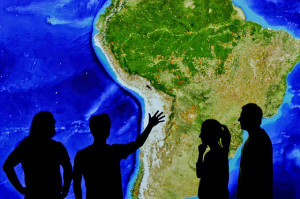By Ruben Echeverria, Director General, Center International Center for Tropical Agriculture (CIAT)

The Amazon rainforest is often described as the ‘lungs of the Earth’. But the forests of South East Asia and Africa are also vitally important – and among the most at risk. That’s why a deforestation early-warning system that’s proving so successful in Latin America will soon be monitoring all the world’s tropical forests – from space. By combining detailed satellite images with a lot of number crunching, the deforestation monitoring system Terra-i harnesses the power of big data to help protect forests, biodiversity, ecosystem services and livelihoods.
With images updated and scrutinized every 16 days, it can distinguish between recent and historical deforestation back to 2004, giving a frighteningly accurate story of forest clearance. It also enables users to identify the drivers of forest loss – from agriculture to mining, road building, urbanization and more.
Launched in Latin America in 2012, the Government of Peru adopted Terra-i as its official deforestation monitoring system two years later. Since then it has been keeping watch over its share of the Amazon rainforest, and flagging new drivers in 2015. Several countries in Central America are poised to adopt it.
Last year also saw a lot of hard work to prepare for the launch of Terra-i in SE Asia and Africa – a move that means the system will soon be watching over all the world’s tropical forests. In SE Asia, we expect early adopters to be Vietnam, Laos and Cambodia – where deforestation rates are among the highest in the world.
The system will also track forest clearance and vegetation change Africa, specifically in the enormously rich, diverse and important Congo Basin.
While some of the images generated by the system can be unnerving, the team behind Terra-I know that when it comes to deforestation, if you can’t measure it you can’t manage it. By giving a clearer idea of where the hotspots are, and what’s likely to be causing them, Terra-i enables governments to develop more robust policies on forest protection.
It can also help them quantify the enormous carbon dioxide emissions generated by forest clearance, meaning they can put a more accurate price on conservation.
The private sector can benefit from Terra-i too, with businesses better able to assess the environmental impact of their activities, which in turn can feed into their corporate social responsibility programs.
These activities go to the heart of the important issues that the CGIAR Research Program on Forests, Trees and Agroforestry is committed to tackling.
The expansion of Terra-i to SE Asia and Africa represents a big step towards uniting scientists and policymakers across the tropics behind a common goal: the protection and management one of our most precious and vulnerable resources.
Terra-i is the result of collaboration between CIAT, Kings College London and the University of Applied Sciences of Western Switzerland (HEIG-VD). It is funded by The Nature Conservancy, The World Resources Institute, Global Forest Watch and the CGIAR Research Program on FTA.
http://geodata.policysupport.org/terra-i











